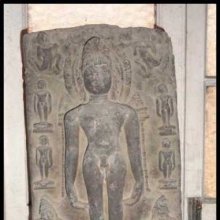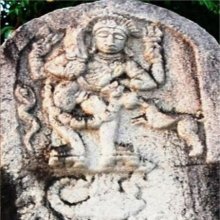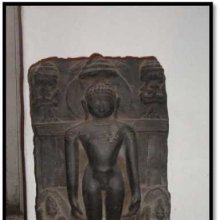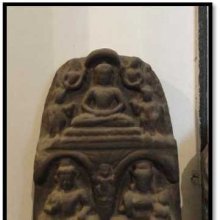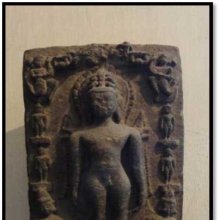Lanchana, Lañchana, Lāñchana, Lamchana, Lāñchanā: 19 definitions
Introduction:
Lanchana means something in Buddhism, Pali, Hinduism, Sanskrit, Jainism, Prakrit, the history of ancient India, Marathi, Hindi. If you want to know the exact meaning, history, etymology or English translation of this term then check out the descriptions on this page. Add your comment or reference to a book if you want to contribute to this summary article.
Alternative spellings of this word include Lanchhana.
Images (photo gallery)
In Hinduism
Ayurveda (science of life)
Nighantu (Synonyms and Characteristics of Drugs and technical terms)
Source: Wisdom Library: Raj NighantuLāñchana (लाञ्छन) refers to the classification of medicinal drugs (auṣadhi) and substances (dravy) according to “characteristic sings or marks”, as defined in the 13th-century Raj Nighantu or Rājanighaṇṭu (an Ayurvedic encyclopedia). Accordingly, “these seven [eg., Lāñchana] are the everlasting sources of the names i.e. names spoken in different regions or countries such as Kāśmīraja, Kāmbojī, Magadhodbhavā or Vālhikā”.
Unclassified Ayurveda definitions
Source: gurumukhi.ru: Ayurveda glossary of termsLāñchana (लाञ्छन):—A mark or sign, one of the basis for naming plants.

Āyurveda (आयुर्वेद, ayurveda) is a branch of Indian science dealing with medicine, herbalism, taxology, anatomy, surgery, alchemy and related topics. Traditional practice of Āyurveda in ancient India dates back to at least the first millenium BC. Literature is commonly written in Sanskrit using various poetic metres.
Shaivism (Shaiva philosophy)
Source: SOAS University of London: Protective Rites in the Netra TantraLāñchana (लाञ्छन) refers to the “mark” (of a vajra), according to the Netratantra of Kṣemarāja: a Śaiva text from the 9th century in which Śiva (Bhairava) teaches Pārvatī topics such as metaphysics, cosmology, and soteriology.—Accordingly, [verse 10.39-45]—“[...] Outside of the lotus, [the Mantrin] should draw the very white śaśimaṇḍala, and outside of that [he is to draw] a square endowed with the mark of a vajra (vajra-lāñchana-lāñchita). Thus, having written [all this] with saffron, bile, and white milk he should worship in peace with an all white [offering]. In this way, he [gives] edible offerings and liquor to the appropriate, voracious form [of the deity]. [...]”.

Shaiva (शैव, śaiva) or Shaivism (śaivism) represents a tradition of Hinduism worshiping Shiva as the supreme being. Closely related to Shaktism, Shaiva literature includes a range of scriptures, including Tantras, while the root of this tradition may be traced back to the ancient Vedas.
In Buddhism
Tibetan Buddhism (Vajrayana or tantric Buddhism)
Source: OSU Press: Cakrasamvara SamadhiLāñchana (लाञ्छन) refers to “(having various sorts of) marks”, according to the Cakrasaṃvara Samādhi [i.e., Cakrasamvara Meditation] ritual often performed in combination with the Cakrasaṃvara Samādhi, which refers to the primary pūjā and sādhanā practice of Newah Mahāyāna-Vajrayāna Buddhists in Nepal.—Accordingly, “A vermillion colored body equal radiance as six heroic Vīriṇī, loving mouth, Naked in arm (nagnabhuja) from the Vasu, a seizer of bodies, with various sorts of marks (nānāvidha-lāñchana)”.

Tibetan Buddhism includes schools such as Nyingma, Kadampa, Kagyu and Gelug. Their primary canon of literature is divided in two broad categories: The Kangyur, which consists of Buddha’s words, and the Tengyur, which includes commentaries from various sources. Esotericism and tantra techniques (vajrayāna) are collected indepently.
In Jainism
General definition (in Jainism)
Source: Singhi Jain Series: Ratnaprabha-suri’s Kuvalayamala-kathaLaṃchaṇa (लंछण) refers to the “distinctive signs” (of Tīrthaṃkaras), according to Uddyotanasūri in his 8th-century Kuvalayamālā (a Prakrit Campū, similar to Kāvya poetry).—Page 128.6: There is a reference to ratnamaī mahāpratimā. By the time of Uddyotanasūri the distinctive signs (laṃchaṇa-laṃchiya) of Tīrthaṃkaras (line 11) had come into existence. They did not exist on the image of the Kushan period but appear to have been introduced in the religion and art of the Gupta period.

Jainism is an Indian religion of Dharma whose doctrine revolves around harmlessness (ahimsa) towards every living being. The two major branches (Digambara and Svetambara) of Jainism stimulate self-control (or, shramana, ‘self-reliance’) and spiritual development through a path of peace for the soul to progess to the ultimate goal.
India history and geography
Source: Cologne Digital Sanskrit Dictionaries: Indian Epigraphical GlossaryLāñchana.—(EI 28), an emblem. Cf. cihna. (EI 9), the [royal] emblem; cf. Tamil lāñjanai-ppeṟu, lāñjinai-ppeṟu, ilāñjai-ppeṟu (SITI), the royal seal. (CII 3, etc.), a crest as distinguished from dhvaja or a banner. Cf. cihna. (HA), the distinguishing mark or symbol of a Jina image, which helps one to identify the different Jinas. Note: lāñchana is defined in the “Indian epigraphical glossary” as it can be found on ancient inscriptions commonly written in Sanskrit, Prakrit or Dravidian languages.

The history of India traces the identification of countries, villages, towns and other regions of India, as well as mythology, zoology, royal dynasties, rulers, tribes, local festivities and traditions and regional languages. Ancient India enjoyed religious freedom and encourages the path of Dharma, a concept common to Buddhism, Hinduism, and Jainism.
Languages of India and abroad
Pali-English dictionary
Source: BuddhaSasana: Concise Pali-English Dictionarylañchana : (nt.) a mark; an imprint.
Source: Sutta: The Pali Text Society's Pali-English DictionaryLañchana, (nt.) (fr. lañch) 1. stamp, mark, imprint VvA. 89 (sasa°, of the moon); Dāvs II. 23 (pada°).—2. the seal (of a letter or edict) SnA 172.—Cp. lañcana. (Page 580)

Pali is the language of the Tipiṭaka, which is the sacred canon of Theravāda Buddhism and contains much of the Buddha’s speech. Closeley related to Sanskrit, both languages are used interchangeably between religions.
Marathi-English dictionary
Source: DDSA: The Molesworth Marathi and English Dictionarylañchana (लंछन).—n (Properly lāñchana).
Marathi is an Indo-European language having over 70 million native speakers people in (predominantly) Maharashtra India. Marathi, like many other Indo-Aryan languages, evolved from early forms of Prakrit, which itself is a subset of Sanskrit, one of the most ancient languages of the world.
Sanskrit dictionary
Source: DDSA: The practical Sanskrit-English dictionaryLāñchana (लाञ्छन).—[lāñch-karmaṇi lyuṭ]
1) A sign, mark, token, characteristic mark; नवाम्बुदानीकमुहूर्तलाञ्छने (navāmbudānīkamuhūrtalāñchane) (dhanuṣi) R.3. 53; Uttararāmacarita 4.2; Mv.1.18; oft. at the end of comp. in the sense of 'marked with.', 'characterized by' &c.; जातेऽथ देवस्य तया विवाहमहोत्सवे साहसलाञ्छनस्य (jāte'tha devasya tayā vivāhamahotsave sāhasalāñchanasya) Vikr.1.1; R.6.18;16.84; so श्रीकण्ठपदलाञ्छनः (śrīkaṇṭhapadalāñchanaḥ) Mālatīmādhava (Bombay) 1 'bearing the characteristic epithet श्रीकण्ठ (śrīkaṇṭha)'.
2) A name, an appellation.
3) A stain, stigma, a mark of ignominy.
4) The spot on the moon; दिवापि निष्ठ्यूतमरीचिभासा बाल्यादना- विष्कृतलाञ्छनेन (divāpi niṣṭhyūtamarīcibhāsā bālyādanā- viṣkṛtalāñchanena) Kumārasambhava 7.35.
5) A landmark.
Derivable forms: lāñchanam (लाञ्छनम्).
Source: Cologne Digital Sanskrit Dictionaries: Shabda-Sagara Sanskrit-English DictionaryLāñchana (लाञ्छन).—n.
(-naṃ) 1. A name, an appellation. 2. A mark or sign. 3. A stain, a mark of ignominy. 4. A land-mark. 5. The spots on the disc of the moon. E. lāñchi to mark, aff. lyuṭ .
Source: Cologne Digital Sanskrit Dictionaries: Benfey Sanskrit-English DictionaryLāñchana (लाञ्छन).—[lāñch + ana], n. 1. A mark, [Pañcatantra] iii. [distich] 204. 2. A name, [Uttara Rāmacarita, 2. ed. Calc., 1862.] 2, 4 (śri-kaṇṭha-pada-, adj. Having as surname the word Śrikaṇṭha.)
Source: Cologne Digital Sanskrit Dictionaries: Cappeller Sanskrit-English DictionaryLāñchana (लाञ्छन).—[neuter] mark, sign, vestige.
Source: Cologne Digital Sanskrit Dictionaries: Monier-Williams Sanskrit-English Dictionary1) Lañchana (लञ्छन):—m. Eleusine Corocana, [cf. Lexicographers, esp. such as amarasiṃha, halāyudha, hemacandra, etc.]
2) Lāñchana (लाञ्छन):—[from lāñch] n. a mark, sign, token (ifc.= marked or, characterized by, furnished or provided with), [Kālidāsa; Bhāgavata-purāṇa]
3) [v.s. ...] a mark of ignominy, stain, spot, [Vikramāṅkadeva-carita, by Bilhaṇa]
4) [v.s. ...] a name, appellation, [cf. Lexicographers, esp. such as amarasiṃha, halāyudha, hemacandra, etc.]
Source: Cologne Digital Sanskrit Dictionaries: Yates Sanskrit-English DictionaryLāñchana (लाञ्छन):—(naṃ) 1. n. A name; a sign.
[Sanskrit to German]
Sanskrit, also spelled संस्कृतम् (saṃskṛtam), is an ancient language of India commonly seen as the grandmother of the Indo-European language family (even English!). Closely allied with Prakrit and Pali, Sanskrit is more exhaustive in both grammar and terms and has the most extensive collection of literature in the world, greatly surpassing its sister-languages Greek and Latin.
Hindi dictionary
Source: DDSA: A practical Hindi-English dictionary1) Lāṃchana (लांछन) [Also spelled lanchhan]:—(nm) a stigma, blemish; slander.
2) Lāṃchanā (लांछना) [Also spelled lanchhana]:—(nf) stigma; blamed; slander.
...
Kannada-English dictionary
Source: Alar: Kannada-English corpusLāṃchana (ಲಾಂಛನ):—
1) [noun] a mark; a symbol; a sign.
2) [noun] a sectarian mark put on the forehead.
3) [noun] the apparent block spot on the disc of the moon.
4) [noun] a defect or flaw; a stain; a blemish.
Kannada is a Dravidian language (as opposed to the Indo-European language family) mainly spoken in the southwestern region of India.
See also (Relevant definitions)
Starts with: Lamchanaspada, Lancanai, Lanchanalakshana, Lanchanata, Lanchanaya.
Ends with (+8): Alanchana, Bhalalamchana, Enalamchana, Enalamchanalamchana, Harinalanchana, Imdulamchana, Kurangalanchana, Makaralanchana, Minalanchana, Mrigalanchana, Nelamchana, Netralamchana, Nillamchana, Nirlanchana, Padalanchana, Padmalanchana, Sahasalanchana, Samajika-lanchana, Sasalanchana, Shivalamchana.
Full-text (+49): Mrigalanchana, Sasalanchana, Padmalanchana, Shrivatsalanchana, Shrikanthapadalanchana, Kurangalanchana, Sahasalanchana, Harinalanchana, Nirlanchana, Lanchhana, Lanchanata, Vikramalanchana, Mrigalanchanaja, Lanchhan, Alanchana, Makaralanchana, Vrishalanchana, Vatsalanchana, Minalanchana, Mrug-laaychhan.
Relevant text
Search found 11 books and stories containing Lanchana, Lañchana, Lāñchana, Lañchanā, Lāṃchanā, Lānchana, Lāṃchana, Lañchaṇā, Laṃchaṇā, Lañchaṇa, Laṃchaṇa, Lamchana, Lāñchanā; (plurals include: Lanchanas, Lañchanas, Lāñchanas, Lañchanās, Lāṃchanās, Lānchanas, Lāṃchanas, Lañchaṇās, Laṃchaṇās, Lañchaṇas, Laṃchaṇas, Lamchanas, Lāñchanās). You can also click to the full overview containing English textual excerpts. Below are direct links for the most relevant articles:
Jain Remains of Ancient Bengal (by Shubha Majumder)
Caubisi type of Candraprabha sculptures < [Chapter 6 - Iconographic Study of Jaina Sculptural Remains]
Pañca-tīrthika type of Ṛṣabhanātha sculptures < [Chapter 6 - Iconographic Study of Jaina Sculptural Remains]
Caubisi type of Ṛṣabhanātha sculptures < [Chapter 6 - Iconographic Study of Jaina Sculptural Remains]
Jainism in Odisha (Orissa) (by Ashis Ranjan Sahoo)
Risabhanatha image at the Gramadevati Shrine, Ramachandrapur < [Chapter 3: Survey of Jaina Antiquities in Odisha]
Jaina Antiquities in Manikchauk (Balasore) < [Chapter 3: Survey of Jaina Antiquities in Odisha]
Jaina Antiquities at Narasinghpur (Jajpur) < [Chapter 3: Survey of Jaina Antiquities in Odisha]
Sahitya-kaumudi by Baladeva Vidyabhushana (by Gaurapada Dāsa)
Text 6.2 < [Chapter 6 - Third-rate Poetry and Super-excellent Poetry]
Text 10.226 < [Chapter 10 - Ornaments of Meaning]
Text 10.107 < [Chapter 10 - Ornaments of Meaning]
Trishashti Shalaka Purusha Caritra (by Helen M. Johnson)
Part 19: The Vyantaras < [Chapter III - The initiation and omniscience of Ajita]
Part 18: The Bhavanapatis < [Chapter III - The initiation and omniscience of Ajita]
Appendix 2.3: new and rare words < [Appendices]
Chaitanya Bhagavata (by Bhumipati Dāsa)
Verse 3.10.1 < [Chapter 10 - The Glories of Śrī Puṇḍarīka Vidyānidhi]
Verse 3.9.357 < [Chapter 9 - The Glories of Advaita]
Verse 3.9.231 < [Chapter 9 - The Glories of Advaita]
The history of Andhra country (1000 AD - 1500 AD) (by Yashoda Devi)
Part 15 - Bettarasa A.D. (1121-1125) < [Chapter XX - The Telugu Cholas (Chodas)]
Part 1 - The Matsyas of Oddadi (A.D. 1200-1470) < [Chapter XIII - The Dynasties in South Kalinga]
Part 2 - Choda I (A.D. 1109—1136—37) < [Chapter I - The Velanandu Chodas of Tsandavole (A.D. 1020-1286)]
